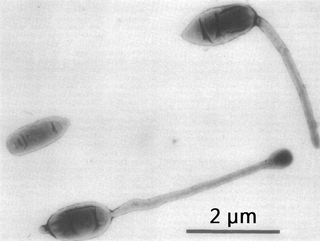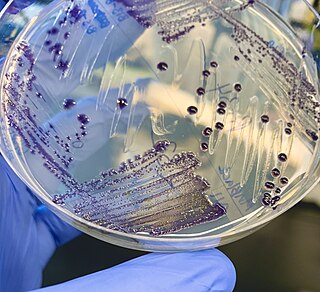
Acidobacteriota is a phylum of Gram-negative bacteria. Its members are physiologically diverse and ubiquitous, especially in soils, but are under-represented in culture.

The Hyphomicrobiaceae are a family of bacteria. Among others, they include Rhodomicrobium, a genus of purple bacteria.
Dehalococcoides is a genus of bacteria within class Dehalococcoidia that obtain energy via the oxidation of hydrogen and subsequent reductive dehalogenation of halogenated organic compounds in a mode of anaerobic respiration called organohalide respiration. They are well known for their great potential to remediate halogenated ethenes and aromatics. They are the only bacteria known to transform highly chlorinated dioxins, PCBs. In addition, they are the only known bacteria to transform tetrachloroethene to ethene.

Cupriavidus necator is a Gram-negative soil bacterium of the class Betaproteobacteria.
Cupriavidus metallidurans is a non-spore-forming, Gram-negative bacterium which is adapted to survive several forms of heavy metal stress.

The genus Massilia is an outdated genus name of bacteria within the family Oxalobacteriaceae. All Massilia species were reclassified in 2023 into one of the following genera: Duganella, Pseudoduganella, Janthinobacterium,Telluria,Rugamonas,Mokoshia, or Zemynaea.
Psychromonas antarctica is a species of Pseudomonadota. The halophilic and psychrophile bacterium was first isolated from a high salinity pond in Antarctica. Psychromonas antarctica is anaerobic but tolerates the presence of oxygen (aerotolerant). It is motile with a polar flagellum.
Desulfosporosinus is a genus of strictly anaerobic, sulfate-reducing bacteria, often found in soil.
Cupriavidus campinensis is a gram-negative soil bacterium of the genus Cupriavidus and the family Burkholderiaceae which was isolated in northeast Belgium. C. campinensis species were found to be highly resistant to heavy metals and antibiotics due to their genomic potentials
Cupriavidus gilardii is a Gram-negative, aerobic, motile, oxidase-positive bacterium from the genus Cupriavidus and the family Burkholderiaceae. It is motil by a single polar flagellum. It is named after G. L. Gilardi, an American microbiologist. The organism was initially identified as Ralstonia gilardii in 1999, renamed Wautersiella gilardii, and most recently moved into the genus Cupriavidus after 16S rRNA gene sequencing revealed it to be most closely related to Cupriavidus necator. Notably, species of this genus are not inhibited by copper due to the production of chelation factors, and may actually be stimulated by the presence of copper.
Cupriavidus pauculus is a Gram-negative, nonfermentative, motile bacterium of the genus Cupriavidus and family Burkholderiaceae isolated from water from ultrafiltration systems and bottled mineral water. C. pauculus is associated with human infections.
Cupriavidus respiraculi is a Gram-negative, nonfermenting bacterium of the genus Cupriavidus and family Burkholderiaceae. It has been isolated from cystic fibrosis patients.
Cupriavidus taiwanensis is a Gram-negative, nitrogen-fixing bacterium of the genus Cupriavidus and family Burkholderiaceae, which forms indeterminate nodules on Mimosa pudica. The genome of C. taiwanensis is completely sequenced.
Exiguobacterium is a genus of bacilli and a member of the low GC phyla of Bacillota. Collins et al. first described the genus Exiguobacterium with the characterization of E. aurantiacum strain DSM6208T from an alkaline potato processing plant. It has been found in areas covering a wide range of temperatures (-12 °C—55 °C) including glaciers in Greenland and hot springs in Yellowstone, and has been isolated from ancient permafrost in Siberia. This ability to survive in varying temperature extremes makes them an important area of study. Some strains in addition to dynamic thermal adaption are also halotolerant, can grow within a wide range of pH values (5-11), tolerate high levels of UV radiation, and heavy metal stress.
Desulfitobacterium hafniense is a species of gram positive bacteria, its type strain is DCB-2T..
Alcanivorax pacificus is a pyrene-degrading marine gammaproteobacterium. It is of the genus Alcanivorax, a group of marine bacteria known for degrading hydrocarbons. When originally proposed, the genus Alcanivorax comprised six distinguishable species. However, A. pacificus, a seventh strain, was isolated from deep sea sediments in the West Pacific Ocean by Shanghai Majorbio Bio-pharm Technology Co., Ltd. in 2011. A. pacificus’s ability to degrade hydrocarbons can be employed for cleaning up oil-contaminated oceans through bioremediation. The genomic differences present in this strain of Alcanivorax that distinguish it from the original consortium are important to understand to better utilize this bacteria for bioremediation.
Acinetobacter nosocomialis is a gram-negative, strictly aerobic bacterium from the genus Acinetobacter isolated from a patient at MetroHealth in Cleveland, Ohio. Acinetobacter nosocomialis belongs to the Acinetobacter calcoaceticus-baumannii complex.
The Coriobacteriia are a class of Gram-positive bacteria within the Actinomycetota phylum. Species within this group are nonsporulating, strict or facultative anaerobes that are capable of thriving in a diverse set of ecological niches. Gordonibacter species are the only members capable of motility by means of flagella within the class. Several species within the Coriobacteriia class have been implicated with human diseases that range in severity. Atopobium, Olsenella, and Cryptobacterium species have responsible for human oral infections including periodontitis, halitosis, and other endodontic infections. Eggerthella species have been associated with severe blood bacteraemia and ulcerative colitis.
Ralstonia pseudosolanacearum is a soil-borne bacterium. It is a vascular phytopathogen that infects host plants through the root system causing wilting disease that causes loss in a wide range of crops. R. pseudosolanacearum is Gram negative and was originally identified as Ralstonia solanacearum, however, in 2014 Safni et al. proposed a taxonomic revision of the Ralstonia solanacearum species complex to reclassify phylotype strains, including R. pseudosolanacearum.

The species Rhizorhabdus wittichii, formerly Sphingomonas wittichii, is a Gram-negative, rod-shaped motile bacterium, with an optimum growth temperature at 30 °C. It forms a greyish white colony. It has been found to have a 67 mol% of DNA G+C content.




